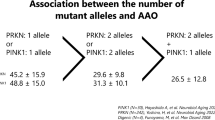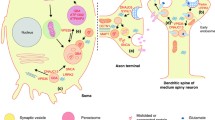Abstract
The identification of Mendelian mutations in rare forms of familial Parkinson’s disease (PD) have provided significant insights into the molecular pathogenesis of this common complex disorder. DJ-1 is the third of four genes known to be definitively causal in familial PD, the three others being α-synuclein, parkin and the recently identified PINK1. Mutations in the DJ-1 gene were identified in two European families, a Dutch kindred harbouring a large homozygous genomic deletion encompassing exons 1–5 of the gene and an Italian kindred with a homozygous L166P missense mutation. The clinical phenotype of the two families was similar to that of parkin cases. Age of onset was in the mid-thirties with good responsiveness to l-dopa and slow disease progression. Focal dystonias and blepharospasm were also evident as were behavioural disturbances early in the course of the disease. To date, there are no studies of pathological material from known DJ-1 patients. It therefore remains to be determined whether these patients form Lewy bodies and/or Lewy neurites, the eosinophilic fibrillary inclusions that contain predominantly α-synuclein and that are the pathological hallmark of PD.
Similar content being viewed by others
References
Abou-Sleiman PM, Healy DG, Quinn N, Lees AJ, Wood NW (2003) The role of pathogenic DJ-1 mutations in Parkinson’s disease. Ann Neurol 54:283–286
Bandopadhyay R, Kingsbury AE, Cookson MR, Reid AR, Evans IM, Hope AD, Pittman AM, Lashley T, Canet-Aviles R, Miller DW, McLendon C, Strand C, Leonard AJ, Abou-Sleiman PM, Healy DG, Ariga H, Wood NW, Silva R de, Revesz T, Hardy JA, Lees AJ (2004) The expression of DJ-1 (PARK7) in normal human CNS and idiopathic Parkinson’s disease. Brain 127:420–430
Bonifati V, Rizzu P, Baren MJ van, Schaap O, Breedveld GJ, Krieger E, Dekker MCJ, Squitieri F, Ibanez P, Joosse M, Dongen JW van, Vanacore N, Sweieten JC van, Brice A, Meco G, Duijn CM van, Oostra BA, Heutnik P (2003) Mutations in the DJ-1 gene associated with autosomal recessive early-onset parkinsonism. Science 299:256–259
Eerola J, Hernandez D, Launes J, Hellstrom O, Hague S, Gulick C, Johnson J, Peuralinna T, Hardy J, Tienari PJ, Singleton AB (2003) Assessment of a DJ-1 (PARK7) polymorphism in Finnish PD. Neurology 61:1000–1002
Goldstein DB (2001) Islands of linkage disequilibrium. Nat Genet 29:109–111
Hague S, Rogaeva E, Hernandez D, Gulick C, Singleton A, Hanson M, Johnson J, Weiser R, Gallardo M, Ravina B, Gwinn-Hardy K, Crawley A, St George-Hyslop PH, Lang AE, Heutink P, Bonifati V, Hardy J, Singleton A (2003) Early-onset Parkinson’s disease caused by compound heterozygous DJ-1 mutation. Ann Neurol 54:271–274
Healy DG, Abou-Sleiman PM, Valente EM, Gilks WP, Bhatia K, Quinn N, Lees AJ, Wood NW (2004) DJ-1 mutations in Parkinson’s disease. J Neurol Neurosurg Psychiatry 75:144–145
Hedrich K, Djarmati A, Schafer N, Hering R, Wellenbrock C, Weiss PH, Hilker R, Vieregge P, Ozelius LJ, Heutink P, Bonifati V, Schwinger E, Lang AE, Noth J, Bressman SB, Pramstaller PP, Riess O, Klein C (2004) DJ-1 (PARK7) mutations are less frequent than Parkin (PARK2) mutations in early-onset Parkinson disease. Neurology 62:389–394
Hod Y, Pentyala SN, Whyard TC, El-Maghrabi MR (1999) Identification and characterization of a novel protein that regulates RNA protein interaction. J Cell Biochem 72:435–444
Honbou K, Suzuki NN, Horiuchi M, Niki T, Taira T, Ariga H, Inagaki F (2003) Crystallization and preliminary crystallographic analysis of DJ-1, a protein associated with male fertility and parkinsonism. J Biol Chem 278:31380–31384
Ibáñez P, De Michele G, Bonifati V, Lohmann E, Thobois S, Pollak P, Agid Y, Heutink P, Dürr A, Brice A, French Parkinson’s Disease Genetics Study Group (2003) Screening for DJ-1 mutations in early onset autosomal recessive parkinsonism. Neurology 61:1429–1431
Khan NL, Valente EM, Bentivoglio AR, Wood NW, Albanese A, Brooks DJ, Piccini P (2002) Clinical and subclinical dopaminergic dysfunction in PARK6-linked parkinsonism: an 18F-dopa PET study. Ann Neurol 52:849–853
Klinefelter GR, Laskey JW, Ferrell J, Suarez JD, Roberts NL (1997) Discriminant analysis indicates a single sperm protein (SP22) is predictive of fertility following exposure to epididymal toxicants. J Androl 18:139–150
Macedo MG, Anar B, Bronner IF, Cannella M, Squitieri F, Bonifati V, Hoogeveen A, Heutink P, Rizzu P (2003) The DJ-1 L166P mutant protein associated with early onset Parkinson’s disease is unstable and forms higher-order protein complexes. Hum Mol Genet 12:2807–2816
Miller DW, Ahmad R, Hague S, Baptista MJ, Canet-Aviles R, McLendon C, Carter DM, Zhu PP, Stadler J, Chandran J, Klinefelter GR, Blackstone C, Cookson MR (2003) L166P mutant DJ-1, causative for recessive Parkinson’s disease, is degraded through the ubiquitin-proteasome system. J Biol Chem 278:36588–36595
Mitsumoto A, Nakagawa Y (2001) DJ-1 is an indicator for endogenous reactive oxygen species elicited by endotoxin. Free Radic Res 35:885–893
Moore DJ, Zhang L, Dawson TM, Dawson VL (2003) A missense mutation (L166P) in DJ-1, linked to familial Parkinson’s disease, confers reduced protein stability and impairs homo-oligomerization. J Neurochem 87:1558–1567
Morris CM, O’Brien KK, Gibson AM, Hardy JA, Singleton AB (2003) Polymorphism in the human DJ-1 gene is not associated with sporadic dementia with Lewy bodies or Parkinson’s disease. Neurosci Lett 352:151–153
Nagakubo D, Taira T, Kitaura H, Ikeda M, Tamai K, Iguchi-Ariga SMM, Ariga H (1997) DJ-1, a novel oncogene which transforms mouse NIH3T3 cells in cooperation with ras. Biochem Biophys Res Commun 231:509–513
Niki T, Takahashi-Niki K, Taira T, Iguchi-Ariga SM, Ariga H (2003) DJBP: a novel DJ-1-binding protein, negatively regulates the androgen receptor by recruiting histone deacetylase complex, and DJ-1 antagonizes this inhibition by abrogation of this complex. Mol Cancer Res 1:247–261
Rizzu P, Hinkle DA, Zhukareva V, Bonifati V, Severijnen LA, Martinez D, Ravid R, Kamphorst W, Eberwine JH, Lee VMY, Trojanowski JQ, Heutink P (2004) DJ-1 colocalizes with Tau inclusions: a link between parkinsonism and dementia. Ann Neurol 55:113–118
Taira T, Saito Y, Niki T, Iguchi-Ariga SMM, Takahashi K, Ariga H (2004) DJ-1 has a role in antioxidative stress to prevent cell death. EMBO Rep 5:213–218
Takahashi K, Taira T, Niki T, Seino C, Iguchi-Ariga SMM, Ariga H (2001) DJ-1 positively regulates the androgen receptor by impairing the binding of PIASxα to the receptor. J Biol Chem 276:37556–37563
Tao X, Tong L (2003) Crystal structure of human DJ-1, a protein associated with early onset Parkinson’s disease. J Biol Chem 278:31372–31379
Wagenfeld A, Gromoll J, Cooper TG (1998) Molecular cloning and expression of rat contraception associated protein 1 (CAP1), a protein putatively involved in fertilization. Biochem Biophys Res Commun 251:545–549
Wilson MA, Collins JL, Hod Y, Ringe D, Petsko GA (2003) The 1.1-Å resolution crystal structure of DJ-1, the protein mutated in autosomal recessive early onset Parkinson’s disease. Proc Natl Acad Sci USA 100:9256–9261
Yokota T, Sugawara K, Ito K, Takahashi R, Ariga H, Mizusawa H (2003) Down regulation of DJ-1 enhances cell death by oxidative stress, ER stress, and proteasome inhibition. Biochem Biophys Res Commun 312:1342–1348
Author information
Authors and Affiliations
Corresponding author
Rights and permissions
About this article
Cite this article
Abou-Sleiman, P.M., Healy, D.G. & Wood, N.W. Causes of Parkinson’s disease: genetics of DJ-1. Cell Tissue Res 318, 185–188 (2004). https://doi.org/10.1007/s00441-004-0922-6
Received:
Accepted:
Published:
Issue Date:
DOI: https://doi.org/10.1007/s00441-004-0922-6




